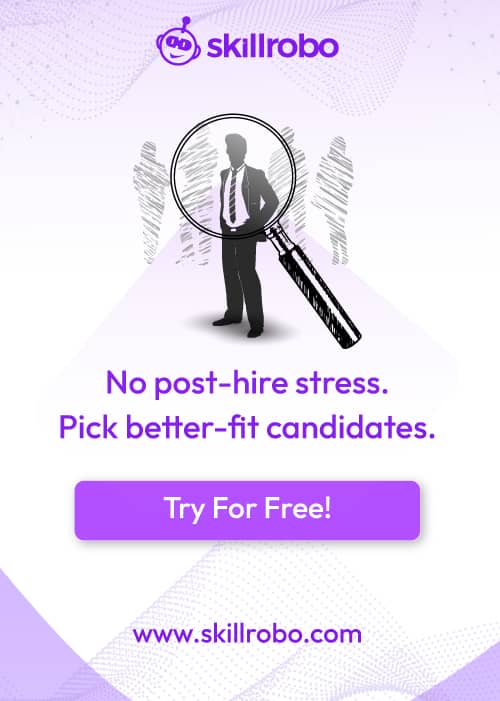Table of Contents
Related articles

As a hiring manager, you know how important it is to find the right candidate for the job. But how do you know if someone is a good fit? Sure, you can look at their resume and ask them questions during an interview, but there’s more to it than that. That’s where the MBTI test comes in.
The Myers-Briggs Type Indicator (MBTI) test is a popular personality assessment tool that has been used for decades to help individuals understand themselves and others better. The test identifies 16 different personality types based on four dichotomies: extraversion vs. introversion, sensing vs. intuition, thinking vs. feeling, and judging vs. perceiving. In addition to personality types, the MBTI assessment Test also explores cognitive functions, which are the mental processes that individuals use to perceive and process information.
In this article, we’ll explore what the MBTI online test is, how it works, and how it can help you find the perfect candidate.
Introduction to the MBTI Test
The MBTI test was created by Isabel Briggs Myers and her mother, Katharine Briggs, in the 1940s. The test is based on the theories of Swiss psychiatrist Carl Jung, who believed that individuals had distinct personality types that influenced how they perceived and interacted with the world around them. The MBTI Personality test has become one of the most widely used personality assessment tools in the world, with millions of people taking the test each year.
The MBTI assessment test is designed to help individuals understand their strengths, weaknesses, and preferences. By identifying their personality type, individuals can gain insight into their communication style, work preferences, and social interactions. The test is often used in personnel who score high on the sensing scale and are detail-oriented and focused on development, team building, and career counseling.
The MBTI personality test is a series of questions that assesses an individual’s preferences in four key areas: Extraversion vs. Introversion, Sensing vs. Intuition, Thinking vs. Feeling, and Judging vs. Perceiving. Based on their answers, the individual is assigned a four-letter personality type.
Understanding the MBTI Personality Types
The MBTI test identifies 16 different personality types based on four dichotomies: extraversion vs. introversion, sensing vs. intuition, thinking vs. feeling, and judging vs. perceiving. Each of the 16 MBTI types comprises a combination of the four preferences mentioned earlier. For example, someone who is an “ENTJ” is someone who prefers Extraversion, Intuition, Thinking, and Judging.
Each type has its own strengths and weaknesses, and understanding these can help you better understand how someone will perform in a given role. Each personality type has unique strengths and weaknesses and is suited for different types of work and social environments.
Individuals who score high on the extraversion scale are outgoing, sociable, and energized by social interactions. Introverts, on the other hand, are more reserved and prefer quiet, solitary activities. Those facts and data, while those who score high on the intuition scale are more interested in possibilities and abstract concepts.
Thinkers are analytical and logical, while feelers are more empathetic and focused on relationships. Judgers are organized and prefer structure, while perceivers are more spontaneous and flexible.
By understanding their personality type, individuals can gain insight into their strengths and weaknesses and use this information to make better decisions and communicate more effectively with others.
Overview of the MBTI Cognitive Functions Test
In addition to personality types, the MBTI test also explores cognitive functions, which are the mental processes that individuals use to perceive and process information. There are eight cognitive functions in total, with four primary functions and four auxiliary functions. The primary functions are the most dominant and influential aspects of an individual’s personality, while the auxiliary functions are less developed but still play an important role in how individuals process information.
The four primary functions are extraverted thinking, extraverted feeling, extraverted sensing, and extraverted intuition. Extraverted thinking is focused on logic and analysis, while the extraverted feeling is focused on relationships and empathy. Extraverted sensing is focused on gathering information through the five senses, while extraverted intuition is focused on exploring possibilities and generating ideas.
The four auxiliary functions are introverted thinking, introverted feeling, introverted sensing, and introverted intuition. Introverted thinking is focused on internal analysis and questioning, while introverted feeling is focused on personal values and beliefs. Introverted sensing is focused on recalling past experiences and details, while introverted intuition is focused on exploring ideas and possibilities in the mind.
MBTI Compatibility Test – Can Your Personality Types Match?
One of the benefits of the MBTI test is its ability to help individuals understand their compatibility with others. While no two individuals are exactly alike, some personality types are more compatible than others. The MBTI compatibility test examines how well two individuals’ personality types and cognitive functions complement each other.
For example, individuals who share the same dominant function but opposite auxiliary functions may be more compatible than those who share the same auxiliary function but opposite dominant functions. The MBTI compatibility test can be useful in personal relationships, team building, and hiring decisions.
How do the MBTI Cognitive Functions Work?
The MBTI cognitive functions are the underlying mental processes that drive our behaviors and decision-making. Each of the four preferences is associated with two cognitive functions. For example, someone who prefers Extraversion is likely to use the cognitive functions of Extraverted Thinking and Extraverted Feeling. Understanding these functions can help you better understand how someone will approach tasks and solve problems.
Benefits of Using the MBTI Test in the Workplace
Using the MBTI test in the hiring process can have a number of benefits. For one, it can help you better understand a candidate’s strengths and weaknesses, which can help you determine if they’re a good fit for the role. There are several benefits to MBTI use in the workplace.
It ends conflict:
It is important that you understand your MBTI personality types so that you may respond to your coworkers in the best way possible. If you are in dispute with a coworker, you may have a better chance of attempting to fix the issue if you are aware of how they handle conflict and arguments.
Improves Team Dynamic:
You’ll see that as you improve your interpersonal relationships and communication, your teamwork also improves. The MBTI can give you a lot of insight into how your team members prefer to collaborate and who they communicate with most effectively. When assembling a team, having this knowledge is helpful because it reduces conflict and matches personalities that don’t clash.
It Promotes Introspection:
Being aware of oneself is essential. This will help you better grasp who you are. Your team can evaluate their emotions and think about how their minds work with the MBTI. To produce high-quality work, especially in the creative sectors, is essential. This enables people to foresee both their own needs and how they will respond to the world and those around them.
Improve Communications:
The MBTI’s promotion of wholesome office communication is among its most notable advantages. Personality type, for instance, can assist employees in understanding how to approach peer-to-peer communication and improve manager-employee relationships. Knowing how each employee works best will help you determine what they will need to execute their jobs effectively.
MBTI Functions Test – Analyzing the Dominant and Inferior Functions
The MBTI functions test examines an individual’s dominant and inferior cognitive functions. Understanding these functions can help individuals gain insight into their strengths and weaknesses and develop strategies for personal and professional growth.
For example, an individual with dominant extraverted thinking and inferior introverted feeling may struggle with expressing their emotions and connecting with others on a personal level. By recognizing this weakness, they can work on developing their emotional intelligence and interpersonal skills.
How the MBTI Test can Improve Workplace Dynamics?
In addition to helping you find the right candidate, the MBTI test can improve workplace dynamics by providing insight into how individuals with different personality types communicate, make decisions, and approach problem-solving. Here are some ways in which the MBTI can improve workplace dynamics:
- Understanding communication styles: The MBTI can help individuals understand their own communication styles as well as the communication styles of their colleagues. This understanding can help people communicate more effectively and avoid misunderstandings.
- Building better teams: By understanding each team member’s personality type, team leaders can build teams that are well-rounded and work together effectively. This can help ensure that all team members feel valued and that their strengths are utilized.
- Improving conflict resolution: Understanding the different ways in which people approach conflict can help individuals resolve conflicts more effectively. For example, individuals with a preference for Thinking may approach conflict in a more logical and objective way, while individuals with a preference for Feeling may approach conflict in a more empathetic and collaborative way.
- Enhancing leadership skills: The MBTI can help individuals know their own leadership style and how they can adapt their style to better lead individuals with different personality types. This can help improve communication and collaboration among team members.
- Fostering a positive work culture: By promoting understanding and appreciation of different personality types, the MBTI can help create a more inclusive and positive work culture. This can help individuals feel more valued and engaged in their work.
MBTI Compatibility and Team Building
One of the most powerful applications of the Myers Briggs Type Indicator test is team building. By understanding each team member’s personality type, you can identify potential areas of conflict and develop strategies to mitigate them. For example, if you have a team with several individuals who prefer Introversion, you may need to create opportunities for them to work independently.
Pros and Cons of Using the MBTI Test
While the MBTI test has many benefits, it is not without its limitations. One of the main criticisms of the test is its lack of scientific validity. While the MBTI has been widely used for decades, there is little evidence to support its accuracy as a measure of personality. Additionally, the test can be limited in its categorization of individuals into 16 distinct personality types, which may not accurately reflect the complexity and diversity of human personality.
However, despite these limitations, the Myers Briggs Type Indicator assessment test can still be a useful tool for personal and professional development. By gaining insight into their personality type and cognitive functions, individuals can better understand themselves and their interactions with others. The test can also provide a framework for team building and career counseling.
Tools and Resources for Administering the MBTI Test
Administering the MBTI test requires specialized training and certification. However, there are a number of tools and resources available to help you learn more about the test and its applications. One such resource is Skillrobo’s pre-employment assessment test, which can help you identify potential candidates who are a good fit for your organization.
Using the MBTI assessment test to gain insight into your personality and cognitive functions, you can better understand yourself and your interactions with others. This can lead to greater personal and professional success and help you build stronger, more fulfilling relationships.
Is the MBTI Test Worth It?
The MBTI test can be a valuable tool for personal and professional development, but it is not without its limitations. Overall, the MBTI personality test is not a pass/fail test; there are no “positive” or “negative” personalities; rather, each of us is unique in our own way and has something to contribute. Knowing yourself allows you to learn a lot more about who you are as a person, including why some things come more naturally to you than others, and your potential areas of strength, and weakness.
However, a manager or human resources manager can choose the option that will benefit their workplace most significantly.
Ultimately, the decision to take the Myers-Briggs Type Indicator test benefits your organization. If you are interested in gaining insight into your candidate’s personality type and cognitive functions, the Myers Briggs Type Indicator online test can be a useful tool. However, it is important to approach the test with an open mind and recognize its limitations.
Just click here to get a free trial of Skillrobo pre-employment assessment software and hire a perfect candidate who fits a desired role.

As a hiring manager, you know how important it is to find the right candidate for the job. But how do you know if someone is a good fit? Sure, you can look at their resume and ask them questions during an interview, but there’s more to it than that. That’s where the MBTI test comes in.
The Myers-Briggs Type Indicator (MBTI) test is a popular personality assessment tool that has been used for decades to help individuals understand themselves and others better. The test identifies 16 different personality types based on four dichotomies: extraversion vs. introversion, sensing vs. intuition, thinking vs. feeling, and judging vs. perceiving. In addition to personality types, the MBTI assessment Test also explores cognitive functions, which are the mental processes that individuals use to perceive and process information.
In this article, we’ll explore what the MBTI online test is, how it works, and how it can help you find the perfect candidate.
Introduction to the MBTI Test
The MBTI test was created by Isabel Briggs Myers and her mother, Katharine Briggs, in the 1940s. The test is based on the theories of Swiss psychiatrist Carl Jung, who believed that individuals had distinct personality types that influenced how they perceived and interacted with the world around them. The MBTI Personality test has become one of the most widely used personality assessment tools in the world, with millions of people taking the test each year.
The MBTI assessment test is designed to help individuals understand their strengths, weaknesses, and preferences. By identifying their personality type, individuals can gain insight into their communication style, work preferences, and social interactions. The test is often used in personnel who score high on the sensing scale and are detail-oriented and focused on development, team building, and career counseling.
The MBTI personality test is a series of questions that assesses an individual’s preferences in four key areas: Extraversion vs. Introversion, Sensing vs. Intuition, Thinking vs. Feeling, and Judging vs. Perceiving. Based on their answers, the individual is assigned a four-letter personality type.
Understanding the MBTI Personality Types
The MBTI test identifies 16 different personality types based on four dichotomies: extraversion vs. introversion, sensing vs. intuition, thinking vs. feeling, and judging vs. perceiving. Each of the 16 MBTI types comprises a combination of the four preferences mentioned earlier. For example, someone who is an “ENTJ” is someone who prefers Extraversion, Intuition, Thinking, and Judging.
Each type has its own strengths and weaknesses, and understanding these can help you better understand how someone will perform in a given role. Each personality type has unique strengths and weaknesses and is suited for different types of work and social environments.
Individuals who score high on the extraversion scale are outgoing, sociable, and energized by social interactions. Introverts, on the other hand, are more reserved and prefer quiet, solitary activities. Those facts and data, while those who score high on the intuition scale are more interested in possibilities and abstract concepts.
Thinkers are analytical and logical, while feelers are more empathetic and focused on relationships. Judgers are organized and prefer structure, while perceivers are more spontaneous and flexible.
By understanding their personality type, individuals can gain insight into their strengths and weaknesses and use this information to make better decisions and communicate more effectively with others.
Overview of the MBTI Cognitive Functions Test
In addition to personality types, the MBTI test also explores cognitive functions, which are the mental processes that individuals use to perceive and process information. There are eight cognitive functions in total, with four primary functions and four auxiliary functions. The primary functions are the most dominant and influential aspects of an individual’s personality, while the auxiliary functions are less developed but still play an important role in how individuals process information.
The four primary functions are extraverted thinking, extraverted feeling, extraverted sensing, and extraverted intuition. Extraverted thinking is focused on logic and analysis, while the extraverted feeling is focused on relationships and empathy. Extraverted sensing is focused on gathering information through the five senses, while extraverted intuition is focused on exploring possibilities and generating ideas.
The four auxiliary functions are introverted thinking, introverted feeling, introverted sensing, and introverted intuition. Introverted thinking is focused on internal analysis and questioning, while introverted feeling is focused on personal values and beliefs. Introverted sensing is focused on recalling past experiences and details, while introverted intuition is focused on exploring ideas and possibilities in the mind.
MBTI Compatibility Test – Can Your Personality Types Match?
One of the benefits of the MBTI test is its ability to help individuals understand their compatibility with others. While no two individuals are exactly alike, some personality types are more compatible than others. The MBTI compatibility test examines how well two individuals’ personality types and cognitive functions complement each other.
For example, individuals who share the same dominant function but opposite auxiliary functions may be more compatible than those who share the same auxiliary function but opposite dominant functions. The MBTI compatibility test can be useful in personal relationships, team building, and hiring decisions.
How do the MBTI Cognitive Functions Work?
The MBTI cognitive functions are the underlying mental processes that drive our behaviors and decision-making. Each of the four preferences is associated with two cognitive functions. For example, someone who prefers Extraversion is likely to use the cognitive functions of Extraverted Thinking and Extraverted Feeling. Understanding these functions can help you better understand how someone will approach tasks and solve problems.
Benefits of Using the MBTI Test in the Workplace
Using the MBTI test in the hiring process can have a number of benefits. For one, it can help you better understand a candidate’s strengths and weaknesses, which can help you determine if they’re a good fit for the role. There are several benefits to MBTI use in the workplace.
It ends conflict:
It is important that you understand your MBTI personality types so that you may respond to your coworkers in the best way possible. If you are in dispute with a coworker, you may have a better chance of attempting to fix the issue if you are aware of how they handle conflict and arguments.
Improves Team Dynamic:
You’ll see that as you improve your interpersonal relationships and communication, your teamwork also improves. The MBTI can give you a lot of insight into how your team members prefer to collaborate and who they communicate with most effectively. When assembling a team, having this knowledge is helpful because it reduces conflict and matches personalities that don’t clash.
It Promotes Introspection:
Being aware of oneself is essential. This will help you better grasp who you are. Your team can evaluate their emotions and think about how their minds work with the MBTI. To produce high-quality work, especially in the creative sectors, is essential. This enables people to foresee both their own needs and how they will respond to the world and those around them.
Improve Communications:
The MBTI’s promotion of wholesome office communication is among its most notable advantages. Personality type, for instance, can assist employees in understanding how to approach peer-to-peer communication and improve manager-employee relationships. Knowing how each employee works best will help you determine what they will need to execute their jobs effectively.
MBTI Functions Test – Analyzing the Dominant and Inferior Functions
The MBTI functions test examines an individual’s dominant and inferior cognitive functions. Understanding these functions can help individuals gain insight into their strengths and weaknesses and develop strategies for personal and professional growth.
For example, an individual with dominant extraverted thinking and inferior introverted feeling may struggle with expressing their emotions and connecting with others on a personal level. By recognizing this weakness, they can work on developing their emotional intelligence and interpersonal skills.
How the MBTI Test can Improve Workplace Dynamics?
In addition to helping you find the right candidate, the MBTI test can improve workplace dynamics by providing insight into how individuals with different personality types communicate, make decisions, and approach problem-solving. Here are some ways in which the MBTI can improve workplace dynamics:
- Understanding communication styles: The MBTI can help individuals understand their own communication styles as well as the communication styles of their colleagues. This understanding can help people communicate more effectively and avoid misunderstandings.
- Building better teams: By understanding each team member’s personality type, team leaders can build teams that are well-rounded and work together effectively. This can help ensure that all team members feel valued and that their strengths are utilized.
- Improving conflict resolution: Understanding the different ways in which people approach conflict can help individuals resolve conflicts more effectively. For example, individuals with a preference for Thinking may approach conflict in a more logical and objective way, while individuals with a preference for Feeling may approach conflict in a more empathetic and collaborative way.
- Enhancing leadership skills: The MBTI can help individuals know their own leadership style and how they can adapt their style to better lead individuals with different personality types. This can help improve communication and collaboration among team members.
- Fostering a positive work culture: By promoting understanding and appreciation of different personality types, the MBTI can help create a more inclusive and positive work culture. This can help individuals feel more valued and engaged in their work.
MBTI Compatibility and Team Building
One of the most powerful applications of the Myers Briggs Type Indicator test is team building. By understanding each team member’s personality type, you can identify potential areas of conflict and develop strategies to mitigate them. For example, if you have a team with several individuals who prefer Introversion, you may need to create opportunities for them to work independently.
Pros and Cons of Using the MBTI Test
While the MBTI test has many benefits, it is not without its limitations. One of the main criticisms of the test is its lack of scientific validity. While the MBTI has been widely used for decades, there is little evidence to support its accuracy as a measure of personality. Additionally, the test can be limited in its categorization of individuals into 16 distinct personality types, which may not accurately reflect the complexity and diversity of human personality.
However, despite these limitations, the Myers Briggs Type Indicator assessment test can still be a useful tool for personal and professional development. By gaining insight into their personality type and cognitive functions, individuals can better understand themselves and their interactions with others. The test can also provide a framework for team building and career counseling.
Tools and Resources for Administering the MBTI Test
Administering the MBTI test requires specialized training and certification. However, there are a number of tools and resources available to help you learn more about the test and its applications. One such resource is Skillrobo’s pre-employment assessment test, which can help you identify potential candidates who are a good fit for your organization.
Using the MBTI assessment test to gain insight into your personality and cognitive functions, you can better understand yourself and your interactions with others. This can lead to greater personal and professional success and help you build stronger, more fulfilling relationships.
Is the MBTI Test Worth It?
The MBTI test can be a valuable tool for personal and professional development, but it is not without its limitations. Overall, the MBTI personality test is not a pass/fail test; there are no “positive” or “negative” personalities; rather, each of us is unique in our own way and has something to contribute. Knowing yourself allows you to learn a lot more about who you are as a person, including why some things come more naturally to you than others, and your potential areas of strength, and weakness.
However, a manager or human resources manager can choose the option that will benefit their workplace most significantly.
Ultimately, the decision to take the Myers-Briggs Type Indicator test benefits your organization. If you are interested in gaining insight into your candidate’s personality type and cognitive functions, the Myers Briggs Type Indicator online test can be a useful tool. However, it is important to approach the test with an open mind and recognize its limitations.
Just click here to get a free trial of Skillrobo pre-employment assessment software and hire a perfect candidate who fits a desired role.








